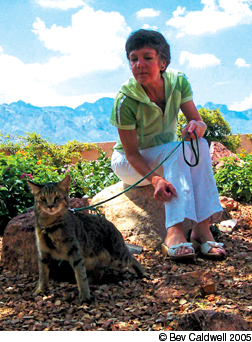Many communities have leash laws for dogs. But is there a similar rule for cats? You may very well ask: Why would anyone want to restrict the freedom of a cat?
Actually, there are many reasons. At least, there are reasons to consider before allowing your cat out the door. However, this column will not discuss the large-scale effects that free-roaming cats may have on the ecosystem because there have already been numerous scientific discussions on the topic.
On a smaller scale, lets consider a neighborhood. In some areas, cats travel happily through fields – or even through city streets – rarely seen by a passing human. They may live an entire lifetime without coming home with an injury. Many outdoor cats appear to deliberately avoid other cats, whereas some cats play well with others.
Perhaps some wild critters may be killed. And there is certainly a risk that the free-roaming cat may himself become victim to wildlife or machinery. But by far, there are few complaints.
On the other side of the spectrum is the cat that travels where he is not wanted. He is let out his door, and instead of staying out of sight, he appears in the windows of neighbors – particularly those neighbors that live with cats of their own.
The consequences? It seems that just the sight of a cat outside the window can trigger a host of responses from an otherwise happy indoor cat. Some cats seem to enjoy the company. And a quiet, sensible – but less social – cat might simply choose a new resting place. Out of sight out of mind, so to speak.
But a bolder or less secure cat might choose to make a statement in another way – urine marking. The telltale sign would be evidence of urine deposited on vertical surfaces near particular windows. Some cats leave nothing to chance and spray near all windows and doorways. Its their way of saying: Keep out!
Fear Can Turn Into Aggression
Perhaps the most serious consequence of the presence of an intruder is aggressive behavior. Fearful cats in particular have been known to attack household cats, dogs and even people in response to the sight of a cat by a window.

252
Can anything be done? It does seem that a large number of the cats that peer into windows do have homes of their own. Therefore, it is certainly possible simply to speak to a neighbor. Describe your concerns and perhaps work out a time-sharing system so that your cat can be safely secured when the neighbors cat roams. Or perhaps your neighbor can set up a cat fence to keep his own pet safe in his own backyard while still enjoying the benefits of being outdoors.
Unless the visiting cat in question appears sickly or emaciated, you should not feed or attend to him. (That may be easier said than done for cat lovers.) Even a little food or attention can motivate this cat to continue to visit your home. But if the cat has a great home of his own, then this vacation home will become a treat for him while simultaneously disturbing the sensitive resident cats.
If all else fails, there are devices that are designed specifically to keep visiting animals from approaching too closely. Repellents that contain offensive odors may be applied near the house. These are not toxic to cats, but they do usually need to be applied on a regular basis. Another option is to place motion sensors outside certain windows in an attempt to teach the cat that he is simply not welcome here.
These sensors are designed not to harm the cat, but simply to create an unpleasant zone. Some devices emit a spritz of air, while others activate a stream of water. The feline visitor can make a choice – tolerate these minor discomforts or find another place to park. Be careful not to use a device that emits a loud sound lest the resident cats (or human neighbors) be disturbed.
For a more permanent solution, consider setting up a cat fence that keeps cats from entering certain areas of your property. Though not always the most aesthetically pleasing, fences are humane. They can be designed to protect windows and doors, or large areas like a backyard.
Obviously, we want to treat all cats fairly. There are many humane options that allow indoor resident cats, as well as outdoor travelers, to lead happy, peaceful and safe lives.



